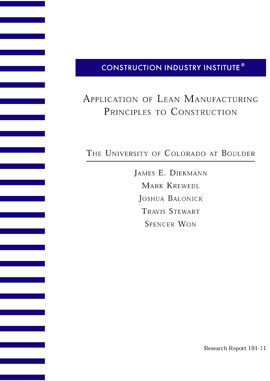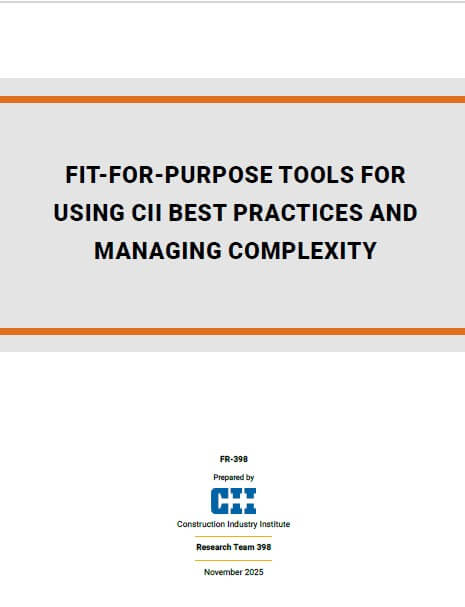
Lean Principles in Construction
The development and application of lean principles in manufacturing have had a dramatic impact in that industry on product costs, capital requirements, quality, cycle times, inventory, and space needs. The construction industry, where significant waste can be identified in the processes of designing and constructing facilities, could perhaps reap similar rewards if the lean principles similar to those in manufacturing could be applied. Major differences exist in the two industries, but construction’s processes could no doubt be improved.
CII began an investigation into this problem by forming the Lean Principles in Construction Project Team (PT191). The mission of PT191 was to examine the potential use of lean principles that were developed in the manufacturing industry for adaptation and use in the construction industry. As part of its investigation, the project team had the objectives of determining if the lean principles as defined in manufacturing can be applied to the construction industry, and if not, are there other principles that are more appropriate for construction?
The team began by defining lean construction as: “the continuous process of eliminating waste, meeting or exceeding all customer requirements, focusing on the entire value stream, and pursuing perfection in the execution of a constructed project.”
The project team’s most significant finding was the large amount of waste activities (defined as anything that takes time, resources or space but does not add value to the product or service delivered to the customer) in construction as compared to manufacturing. The research determined that only 10 percent of field construction activities add value (according to lean manufacturing standards).
PT191 interviewed lean manufacturers, early adopters of lean construction methods, and academics and theorists from around the world. Using all of this information led to the identification of five lean construction principles:
- Customer focus
- Culture and people
- Workplace organization and standardization
- Elimination of waste
- Continuous improvement and built-in quality
Although PT191 could not identify anyone who has been successful in applying the lean theory to the entire engineer-procure-construct (EPC) process, it believes that a huge opportunity for improvement exists in the industry through the application of the lean construction principles. Those principles and the research that was the foundation for their development are summarized in the following pages.
Waste in Construction Processes include:
- Excessive material handling
- Rework
- Design errors
- Conflicts between trades
- Conflicts between other contractors
- Ineffective supply chains
The research notes similarities and differences between “manufacturing principles” and “construction principles.” Below are samples of the findings. The complete list is detailed in the research. (RS191-1, p 5)
Customer Focus
- Constructors do not control the entire supply chain.
- The largest constructors control only one percent of the market, whereas in manufacturing the largest manufacturers may control 20 percent or more.
Culture/People
- High turnover results in less opportunity for training.
- Construction workers are craft skilled; in manufacturing they are process specialized.
Workplace Standardization
- Construction has a fluid organization at the project level.
- The configuration of the production environment changes all of the time, more difficult to maintain visual management systems.
Elimination of Waste
- To a large extent the production sequence is discretionary.
- Material flow is not steady-state; supply lines are different at different project locations.
Continuous Improvement/Built-in Quality
- High turnover/less opportunity for training.
- Ability to develop a quality-tracking program is difficult.
The primary issue common to this list is the much greater degree of discretionary behavior and larger amounts of uncertainty that is evident in construction. Whereas in manufacturing, production systems are defined by and controlled by the configuration of the production line, in construction the production system is defined by project managers and the individual workers.
Regarding the construction production process, this research indicates that typically construction activities are only 10 percent value adding. If a contractor could improve the value-adding portion to just 5, 10, 15, or 20 percent, the lean contractor would have a significant competitive advantage. (RS191-1, p 17)
Rewards to “Go Lean”
- Reduce waste / improve efficiency
- Improve safety
- Lower cost
- Reliable Schedules
- Fewer defects / less rework
The most significant barriers to lean construction are: (RS191-1, p 18)
- Little general understanding of lean
- Unique projects and unique design limit lean implementation
- Difficult to establish a lean culture due to lack of steady-state
- No control of the entire values stream
The suggested method of establishing a foundation of lean in an organization is as follows: (RS191-1, p 19)
- Establish management commitment at the highest levels in an organization. If leaders are not committed, the resources to insure that lean is successful are not likely to be available.
- Identify a champion who has a mandate to lead.
- Train personnel at all levels in the theory and practice of lean.
- Identify the improvement opportunities that are specific to the organization. The organizations in this study each found some “targets of opportunity” that could be remedied fairly easily and that these successes helped to spur greater interest in lean.
Once these initial steps have been taken, the following is the suggested path:
- Identify waste in field operations
- Drive out the waste
- Standardize the workplace
- Develop a lean culture
- Get your client involved with the lean transformation
- Continuously improve
RS191-1, Lean Wheel
The wheel is a tool to simplify and organize the lean principles into a format that is easily communicated to and understood by those new to lean theory. At the highest level the wheel organizes lean ideas into five lean fundamental principles, and is further divided into sub-principles. (RS191-1, p 7)
RS191-1, Lean Principles for Construction
A comprehensive assessment of the applicability of lean construction principles to the construction process.(RS191-1, p.22)



